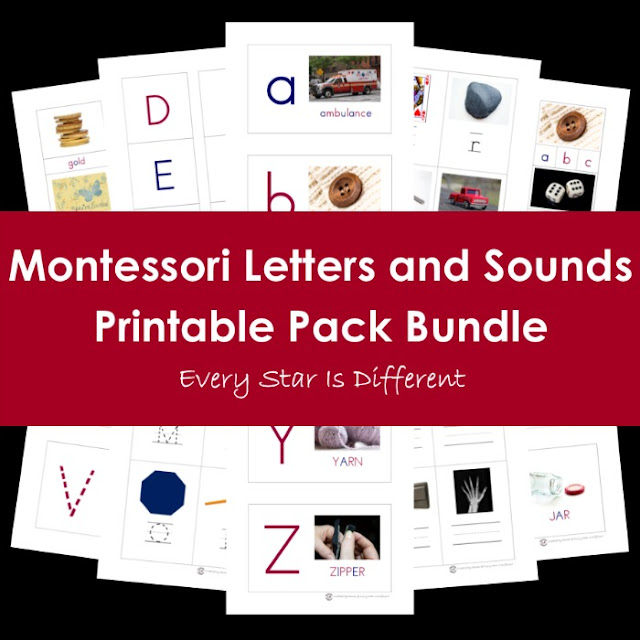Maria Montessori was brilliant in the way she broke down the process of learning letters and sounds.
My oldest did not attend a Montessori preschool and missed out on the magic that occurs when using Montessori materials and lessons.
But my three youngest have had the chance to experience it all. The younger three have such an advantage over the oldest.
At first, I'll admit I was skeptical, but then I started observing my children.
To see how learning the Montessori Way was completely transforming their learning habits and abilities for the better was a miracle I didn't think possible.
The whining stopped. There were no meltdowns. My children were joyous as they completed their work.
Learning the Montessori Way: Letters and Sounds
Here's how it all works! Mind you this is a very basic overview. There is so much more to be learned. But, if you're starting from scratch this should surely be enough to get you headed in the right direction.
Before language materials are introduced to a toddler or preschooler, phonetic awareness can be taught using simple games such as "I Spy!" The Learning Ark provides details and instructions about the game.
Montessori Sandpaper Letters
Children begin their language journey using the Montessori Lower Case Cursive Sandpaper Letters. Yes, you read that correctly. Most children in Montessori schools learn cursive first. Why?
- It is much easier for little hands.
- There is only one starting place.
- Children don't have to worry about starting and stopping with each line and letter.
- The letters are full of loops and curves.
- Reversing letters occurs less often when writing in cursive.
Bulldozer has struggled for YEARS trying to write his letters in print correctly and still makes mistakes often. When he writes in cursive, errors in formation are very rare. Dinomite doesn't struggle with letter reversal issues like he did when writing in print. It's a win-win situation for everyone.
Now to be fair, not ALL Montessori schools teach cursive first. It depends on the training of the teacher and how the children respond etc. So, if you'd prefer to teach your child print first, the same materials used to teach cursive are available in print.
When introducing letters, you do not introduce them by name, but by sound. I'll repeat myself, just to make sure the concept sinks in. In Montessori schools, letters are introduced by sound, not letter name.
As with all Montessori lessons, there are 3 periods. The same is true when working with the sandpaper letters.
As with all Montessori lessons, there are 3 periods. The same is true when working with the sandpaper letters.
You can see an example of a three period lesson at Living Montessori Now. If you're unsure about the pronunciation of each sound, Living Montessori Now provides a video with instruction.
No more than a couple letter sounds are introduced at a time. There is no specified order of introduction, other than making sure that the letters don't look and/or sound alike.
No more than a couple letter sounds are introduced at a time. There is no specified order of introduction, other than making sure that the letters don't look and/or sound alike.
In our home, I prefer to introduce letters in the order of our Bob Books, Set 1: Beginning Readers .
.
Living Montessori Now has a fabulous post with several different options of introducing letter sounds.
If you are looking for mini figures to use in your activities, the Montessori Language Manipulatives from Montessori by Mom are fabulous!
For those children who may need more work with letter sounds, you may want to consider our Montessori Letters and Sounds Printable Pack Bundle.
From there you can progress to the Montessori Blue Series work, which focuses on consonant blends. The Montessori Intermediate Language Bundle is the perfect way to help.
After a child has learned CVC words and consonant blends, working through Pink and Blue Series material, you can also introduce phonograms using the Montessori Cursive Sandpaper Double Letters.
Some teachers prefer to wait, but there is no need if you feel the child is ready.
Remember, you always want to follow the child. Just like with single letters, only sounds are introduced.
For a better understanding of how to introduce phonograms, I highly recommend watching the video in a post from Living Montessori Now.
Montessori Moveable Alphabet
The Montessori Cursive Moveable Alphabet is the next Montessori material introduced when learning letters and sounds. For instructions on how to present the moveable alphabet, visit the Montessori Primary Guide.
Once there is a basic understanding of how to use the moveable alphabet, there are multiple activities that can be created to go along with the material.
All other materials now used in some Montessori curriculum were created by others to supplement the original lessons and activities.
If you're looking for more resources, the bundles below have been such an incredible addition to our classroom.
Final Thoughts
Teaching sounds first is a good example of how insightful Montessori was about the way that children learn. Experience taught her that the identification of letter names, capital letters, and their corresponding sounds come naturally to children, after they are introduced to the sounds first.
If you have observed that a child is not able to identify letters by name in kindergarten, you may need to plan time to teach them. The same goes for uppercase letters. Once you have finished teaching cursive or print, you will teach the other form, if the child hasn't already picked it up on their own.
If you enjoyed this post, you may also enjoy the posts below.



.jpg)

















This is an awesome resource. Thanks
ReplyDeleteThank you for sharing! I'm curious how children transition into reading when their taught cursive first? Since all early reader books are written in print, I feel like I should start with that first. Though it makes since to teach cursive since it is so much easier to write
ReplyDeleteWe love our sandpaper letters! The minute I think we can keep it away, is usually the time when we discover we still need to revisit the work.
ReplyDeleteI love how you put this Montessori language resource together so that we can understand the sequence of events for learning. Thank you! Great link up too! ;)
ReplyDeleteGreat article. It's easy and simple to understand for anybody - truly useful! :)
ReplyDeleteA wonderful breakdown and summary of the essentials. Thank you for sharing!
ReplyDeleteThank you for the post and it is very useful. Playschool is very important for a kid. Parents search for the best place to learn. The best place to enroll tour kid name in such a place like Montessori Schools in Velachery for the bright future.
ReplyDeleteThis was a great and useful information.bless you
ReplyDeleteI absolutely loved reading your blog post about learning the Montessori way for letters and sounds! Your insights into incorporating promocodehq into the Montessori method are truly inspiring.
ReplyDelete